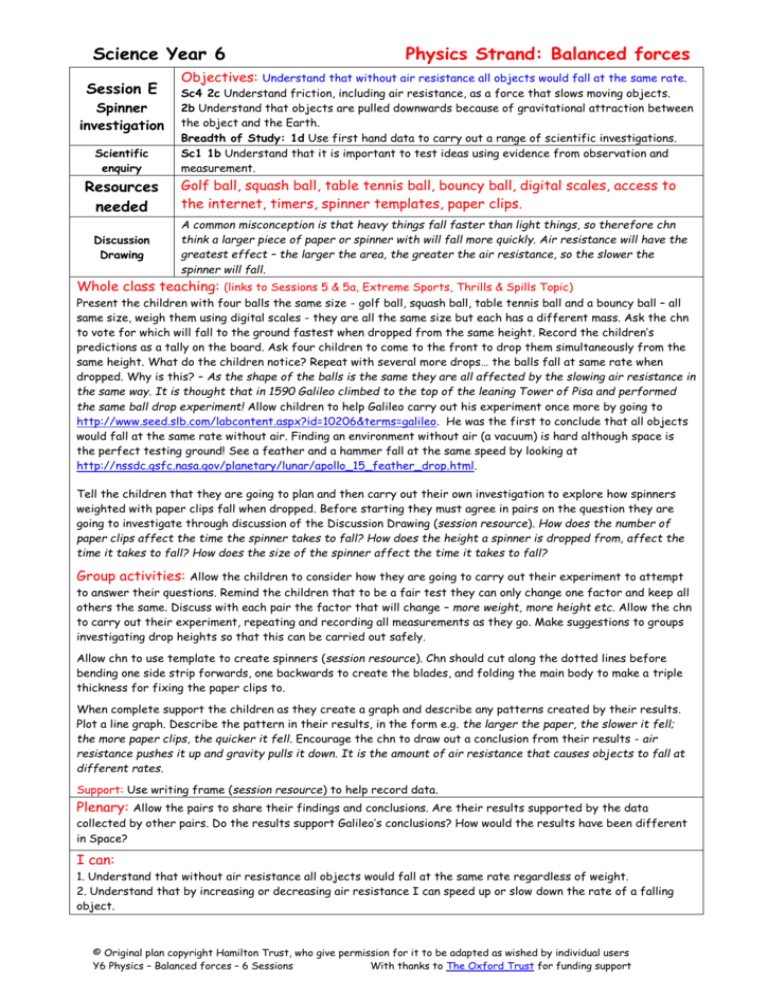UKS2_Sc_Y6_SE_Balanced_forces.doc
advertisement

Science Year 6 Session E Spinner investigation Scientific enquiry Resources needed Discussion Drawing Physics Strand: Balanced forces Objectives: Understand that without air resistance all objects would fall at the same rate. Sc4 2c Understand friction, including air resistance, as a force that slows moving objects. 2b Understand that objects are pulled downwards because of gravitational attraction between the object and the Earth. Breadth of Study: 1d Use first hand data to carry out a range of scientific investigations. Sc1 1b Understand that it is important to test ideas using evidence from observation and measurement. Golf ball, squash ball, table tennis ball, bouncy ball, digital scales, access to the internet, timers, spinner templates, paper clips. A common misconception is that heavy things fall faster than light things, so therefore chn think a larger piece of paper or spinner with will fall more quickly. Air resistance will have the greatest effect – the larger the area, the greater the air resistance, so the slower the spinner will fall. Whole class teaching: (links to Sessions 5 & 5a, Extreme Sports, Thrills & Spills Topic) Present the children with four balls the same size - golf ball, squash ball, table tennis ball and a bouncy ball – all same size, weigh them using digital scales - they are all the same size but each has a different mass. Ask the chn to vote for which will fall to the ground fastest when dropped from the same height. Record the children’s predictions as a tally on the board. Ask four children to come to the front to drop them simultaneously from the same height. What do the children notice? Repeat with several more drops… the balls fall at same rate when dropped. Why is this? – As the shape of the balls is the same they are all affected by the slowing air resistance in the same way. It is thought that in 1590 Galileo climbed to the top of the leaning Tower of Pisa and performed the same ball drop experiment! Allow children to help Galileo carry out his experiment once more by going to http://www.seed.slb.com/labcontent.aspx?id=10206&terms=galileo. He was the first to conclude that all objects would fall at the same rate without air. Finding an environment without air (a vacuum) is hard although space is the perfect testing ground! See a feather and a hammer fall at the same speed by looking at http://nssdc.gsfc.nasa.gov/planetary/lunar/apollo_15_feather_drop.html. Tell the children that they are going to plan and then carry out their own investigation to explore how spinners weighted with paper clips fall when dropped. Before starting they must agree in pairs on the question they are going to investigate through discussion of the Discussion Drawing (session resource). How does the number of paper clips affect the time the spinner takes to fall? How does the height a spinner is dropped from, affect the time it takes to fall? How does the size of the spinner affect the time it takes to fall? Group activities: Allow the children to consider how they are going to carry out their experiment to attempt to answer their questions. Remind the children that to be a fair test they can only change one factor and keep all others the same. Discuss with each pair the factor that will change – more weight, more height etc. Allow the chn to carry out their experiment, repeating and recording all measurements as they go. Make suggestions to groups investigating drop heights so that this can be carried out safely. Allow chn to use template to create spinners (session resource). Chn should cut along the dotted lines before bending one side strip forwards, one backwards to create the blades, and folding the main body to make a triple thickness for fixing the paper clips to. When complete support the children as they create a graph and describe any patterns created by their results. Plot a line graph. Describe the pattern in their results, in the form e.g. the larger the paper, the slower it fell; the more paper clips, the quicker it fell. Encourage the chn to draw out a conclusion from their results - air resistance pushes it up and gravity pulls it down. It is the amount of air resistance that causes objects to fall at different rates. Support: Use writing frame (session resource) to help record data. Plenary: Allow the pairs to share their findings and conclusions. Are their results supported by the data collected by other pairs. Do the results support Galileo’s conclusions? How would the results have been different in Space? I can: 1. Understand that without air resistance all objects would fall at the same rate regardless of weight. 2. Understand that by increasing or decreasing air resistance I can speed up or slow down the rate of a falling object. © Original plan copyright Hamilton Trust, who give permission for it to be adapted as wished by individual users Y6 Physics – Balanced forces – 6 Sessions With thanks to The Oxford Trust for funding support








